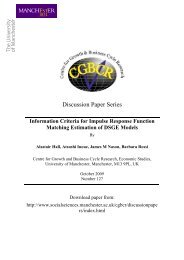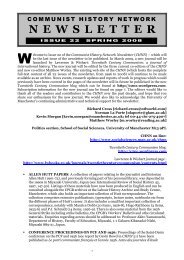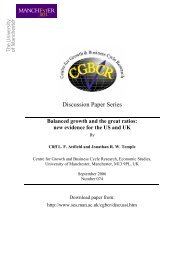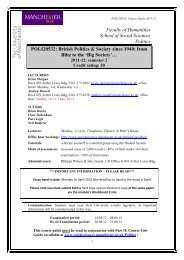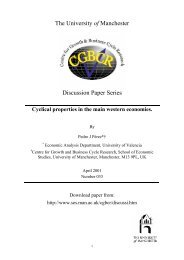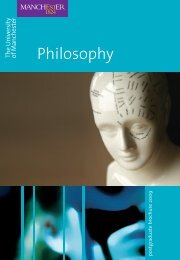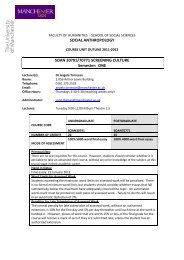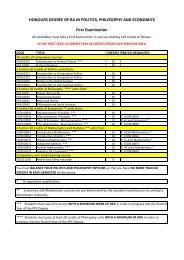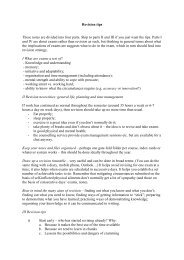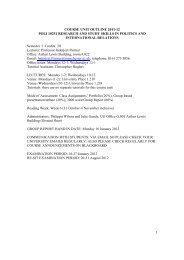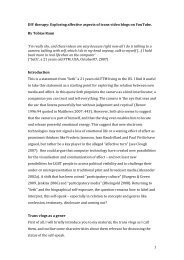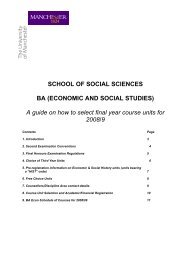second year course outlines 2012-2013 - School of Social Sciences ...
second year course outlines 2012-2013 - School of Social Sciences ...
second year course outlines 2012-2013 - School of Social Sciences ...
Create successful ePaper yourself
Turn your PDF publications into a flip-book with our unique Google optimized e-Paper software.
Kelly, S. 1999. What do we see (when we do)? Philosophical Topics 27 (1999)<br />
Also available at www.people.fas.harvard.edu/~sdkelly<br />
Further Reading:<br />
*Carman, T. 2008. Merleau-Ponty. London: Routledge, Ch.2 [S]<br />
*Kelly, S. 2005. Seeing Things in Merleau-Ponty. In T. Carman & M. Hansen, eds. The<br />
Cambridge Companion to Merleau-Ponty. Cambridge: Cambridge University Press. [O]<br />
Kennedy, M. J. 2007. Visual Awareness <strong>of</strong> Properties. Philosophy and Phenomenological<br />
Research 75 (2007) [O]<br />
Madary, M. 2008. Specular Highlights as a Guide to Perceptual Content. Philosophical<br />
Psychology 28 (2008) [O]<br />
*Madary, M. 2010. Husserl on Perceptual Constancy. European Journal <strong>of</strong> Philosophy. [O]<br />
Noë, A. 2005. Real Presence. Philosophical Topics 33 (2005)<br />
Also available at http://socrates.berkeley.edu/~noe/<br />
Overgaard, S. 2010. On the Looks <strong>of</strong> Things. Pacific Philosophical Quarterly 91 (2010) [O]<br />
Siewert, C. 2006. Is Shape Appearance Protean? Psyche 12 (2006) [O]<br />
21<br />
The Topic<br />
In perceptual experience we are not only aware <strong>of</strong> objects and events, we are also aware <strong>of</strong><br />
the<br />
ways these things are. That is, we are aware <strong>of</strong> properties. How are properties given in<br />
experience? In particular, how is it, if at all, that an object’s properties (shape, size, colour)<br />
are<br />
given as constant despite the fact that the object is presented from constantly changing<br />
perspectives, in constantly changing ‘adumbrations’? A number <strong>of</strong> different answers to this<br />
question have been proposed by philosophers and psychologists, amongst them Merleau-<br />
Ponty.<br />
Merleau-Ponty presents his philosophy as situated between two extremes, that he calls<br />
‘empiricism’ and ‘intellectualism’. Rejecting both ‘empiricist’ and ‘intellectualist’ accounts <strong>of</strong><br />
perceptual constancy, Merleau-Ponty presents his own view that constancy is a<br />
consequence <strong>of</strong><br />
the fact that the perception <strong>of</strong> objects is, in a certain sense, normative and always situated<br />
within a<br />
perceptual context.<br />
Merleau-Ponty’s account can be criticised by arguing that not all objects are perceived in<br />
relation<br />
to a norm, or by arguing that he imposes too stringent requirements on the alternative views<br />
that<br />
he considers.<br />
The Reading<br />
This week’s reading, the first part <strong>of</strong> ‘The Thing and the Natural World’, is a selection from<br />
Merleau-Ponty’s main work Phenomenology <strong>of</strong> Perception. Like the rest <strong>of</strong> the book, it is<br />
dense<br />
and can be difficult to follow, partly due to its literary style (Merleau-Ponty, like Sartre, took<br />
the<br />
view that an accurate description <strong>of</strong> phenomena <strong>of</strong>ten demands such language), partly due<br />
to the<br />
complexity <strong>of</strong> the discussion. Merleau-Ponty first deals with shape and size. The views that<br />
he<br />
rejects—the ‘empiricist’ view <strong>of</strong> the ‘psychologist’ and the ‘intellectualist’ view associated with<br />
Kant—are introduced and rejected within the first few pages, his owns view articulated soon<br />
after.<br />
Next Merleau-Ponty turns to the case <strong>of</strong> colour—about which he has a good deal more to<br />
say.<br />
Much <strong>of</strong> this discussion is difficult, especially the lengthy account <strong>of</strong> lighting.<br />
55



